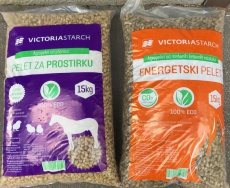Victoria Starch on the market with two agro-pellet products

Victoria Starch, the youngest member company from the Victoria Group business system, began continuous production of agro-pellets, i.e. pellets from agricultural biomass, in mid-2013.
Agro-pellets are a cylindrical, smooth and odorless products obtained by pressing biomass – crop residue (soybean, wheat and rapeseed straw) under high pressure, without adding any binding agents. In this way the sustainable use of agricultural biomass as a renewable energy source is achieved.
Agro-pellets have two main uses: for burning in boilers and as litter for breeding animals. Accordingly, Victoria Starch put two new products on the market available in 15kg, 25kg and 1t packages and in bulk.
Energy pellets are agro-pellets from crop residue with a minimum soybean straw content of 50%. Pellets are a cost-effective and environmentally-friendly energy source intended for a wide variety of purposes. They can be used in all agro-pellet-fueled furnaces in households and public institutions, as well as pellet-fueled furnaces with mechanical grille cleaning. Pellet burning generates the same amount of CO2 that the biomass utilized during its “growth”, which is why pellets are considered a CO2-neutral energy source. They contain no sulfur, so there is no sulfur oxide emission. They are also considered to be a highly efficient fuel in solid fuel boilers.
Pellets for animal litter are made of wheat straw. As a completely natural, high hygienic value product, pellets are the best choice for animal litter. They are suitable for breeding chicks, egg laying hens, turkeys, and they are also great for horses and other animals. Pellets are manufactured at 920C, which guarantees complete microbiological safety of the product. The absorption power of pellets is nine times greater than that of straw, which provides more comfort for animals and enables them to remain on dry ground. Better breeding conditions thanks to the high absorption power of pellets result in the better yield and lower mortality rate of poultry. In addition, the use of pellets as litter has a number of additional benefits, such as: the elimination of odors in breeding facilities, easier and faster cleaning of facilities, and a decrease in the amount of waste, which can be used as fertilizer more easily and efficiently.
